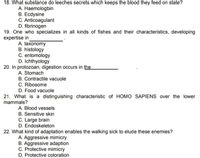
Human Anatomy & Physiology (11th Edition)
11th Edition
ISBN: 9780134580999
Author: Elaine N. Marieb, Katja N. Hoehn
Publisher: PEARSON
expand_more
expand_more
format_list_bulleted
Question

Transcribed Image Text:18. What substance do leeches secrets which keeps the blood they feed on state?
A. Haemologbin
B. Ecdysine
C. Anticoagulant
D. fibrinogen
19. One who specializes in all kinds of fishes and their characteristics, developing
expertise in
A. taxonomy
B. histology
C. entomology
D. Ichthyology
20. In protozoan, digestion occurs in the
A. Stomach
B. Contractile vacuole
C. Ribosome
D. Food vacuole
21. What is a distinguishing characteristic of HOMO SAPIENS over the lower
mammals?
A. Blood vessels
B. Sensitive skin
C. Large brain
D. Endoskeleton
22. What kind of adaptation enables the walking sick to elude these enemies?
A. Aggressive mimicry
B. Aggressive adaption
C. Protective mimicry
D. Protective coloration
Expert Solution
This question has been solved!
Explore an expertly crafted, step-by-step solution for a thorough understanding of key concepts.
Step by stepSolved in 2 steps

Knowledge Booster
Learn more about
Need a deep-dive on the concept behind this application? Look no further. Learn more about this topic, biology and related others by exploring similar questions and additional content below.Similar questions
- Two of the most commonly studied model organisms nowadays are the invertebrates andarrow_forwardlook at the list below. Pick out the ones that are listed as part of the flat worms.... A. tapeworms such as beef tapeworms (these were in the big plastic box with a black background in lab, and were a pale white in color). B. tick C. nematodes, such as the ones dissected D. flukes such as liver flukesarrow_forwardFamily of: 1.Bee 2.Butterfly 3.Beearrow_forward
- Label the picture 1. Identify the following: A._ ______________ B._ _____________ C._ __________________ D._ _________________ E._ ________________arrow_forwardWhat is serum? A. Help cells grown in a Petri dish even when important nutrients are present B. Usually prepared from the blood of calves or fetal calves C. Has growth factors that induces cells to proliferate D. B and C only E. A, B and Carrow_forward22. An easy way to screen for the presence of seminal fluid in a large area is to use A. visible light C. UV light 23. The study of body fluids for the presence of drugs and poi- sons is called B. X-rays D. infrared light A. pathology C. virology B. toxicology D. urology 24. Most screening tests for drugs are based on B. RIA D. GC/MS A. EMIT C. FPIAarrow_forward
- 1. Mentions fluids and rates used in the Tail docking procedure in dogs. Mentions fluids and rates used in the Dewclaw Removal procedure in dogs. 2. Mention the medications that can be used before and after for Tail Docking surgery in dogs? 3. Mention the medications that can be used before and after for Dewclaw Removal surgery in dogs?arrow_forwardAn unidentified animal is noted to possess the following characteristics: triploblastic eucoelomate body a cuticle that is shed via ecdysis To which of the following phyla does this organism belong? Group of answer choices A. Echinodermata B. Annelida C. Arthropoda D. Nematodaarrow_forwardAll of the following are true of Ctenophores except: A. Some species have long tentacles B. They catch food with stingers C. They move with tiny rows of cilia along their outsides D. They are diploblasticarrow_forward
- A cartilaginous skeleton, gills, and a 2 chambered heart are all characteristics of __________________________. Hag fish Salmon Stingrays Both A and C Both B and C All of the abovearrow_forwardWhich of the following are examples of taphonomy? A. Weathering B. Burned Bone C. Cut Marks D. Carnivore Damage E. All of the abovearrow_forwardWhich of the following in sponges form the outermost epithelium-like layer that is in contact with the external, aquatic environment? a. Pinacocytes and choanocytes b. Pinacocytes only c. Choanocytes and collencytes d. Pinacocytes and collencytes e. Choanocytes only f. Collencytes onlyarrow_forward
arrow_back_ios
SEE MORE QUESTIONS
arrow_forward_ios
Recommended textbooks for you
 Human Anatomy & Physiology (11th Edition)BiologyISBN:9780134580999Author:Elaine N. Marieb, Katja N. HoehnPublisher:PEARSON
Human Anatomy & Physiology (11th Edition)BiologyISBN:9780134580999Author:Elaine N. Marieb, Katja N. HoehnPublisher:PEARSON Biology 2eBiologyISBN:9781947172517Author:Matthew Douglas, Jung Choi, Mary Ann ClarkPublisher:OpenStax
Biology 2eBiologyISBN:9781947172517Author:Matthew Douglas, Jung Choi, Mary Ann ClarkPublisher:OpenStax Anatomy & PhysiologyBiologyISBN:9781259398629Author:McKinley, Michael P., O'loughlin, Valerie Dean, Bidle, Theresa StouterPublisher:Mcgraw Hill Education,
Anatomy & PhysiologyBiologyISBN:9781259398629Author:McKinley, Michael P., O'loughlin, Valerie Dean, Bidle, Theresa StouterPublisher:Mcgraw Hill Education, Molecular Biology of the Cell (Sixth Edition)BiologyISBN:9780815344322Author:Bruce Alberts, Alexander D. Johnson, Julian Lewis, David Morgan, Martin Raff, Keith Roberts, Peter WalterPublisher:W. W. Norton & Company
Molecular Biology of the Cell (Sixth Edition)BiologyISBN:9780815344322Author:Bruce Alberts, Alexander D. Johnson, Julian Lewis, David Morgan, Martin Raff, Keith Roberts, Peter WalterPublisher:W. W. Norton & Company Laboratory Manual For Human Anatomy & PhysiologyBiologyISBN:9781260159363Author:Martin, Terry R., Prentice-craver, CynthiaPublisher:McGraw-Hill Publishing Co.
Laboratory Manual For Human Anatomy & PhysiologyBiologyISBN:9781260159363Author:Martin, Terry R., Prentice-craver, CynthiaPublisher:McGraw-Hill Publishing Co. Inquiry Into Life (16th Edition)BiologyISBN:9781260231700Author:Sylvia S. Mader, Michael WindelspechtPublisher:McGraw Hill Education
Inquiry Into Life (16th Edition)BiologyISBN:9781260231700Author:Sylvia S. Mader, Michael WindelspechtPublisher:McGraw Hill Education

Human Anatomy & Physiology (11th Edition)
Biology
ISBN:9780134580999
Author:Elaine N. Marieb, Katja N. Hoehn
Publisher:PEARSON

Biology 2e
Biology
ISBN:9781947172517
Author:Matthew Douglas, Jung Choi, Mary Ann Clark
Publisher:OpenStax

Anatomy & Physiology
Biology
ISBN:9781259398629
Author:McKinley, Michael P., O'loughlin, Valerie Dean, Bidle, Theresa Stouter
Publisher:Mcgraw Hill Education,

Molecular Biology of the Cell (Sixth Edition)
Biology
ISBN:9780815344322
Author:Bruce Alberts, Alexander D. Johnson, Julian Lewis, David Morgan, Martin Raff, Keith Roberts, Peter Walter
Publisher:W. W. Norton & Company

Laboratory Manual For Human Anatomy & Physiology
Biology
ISBN:9781260159363
Author:Martin, Terry R., Prentice-craver, Cynthia
Publisher:McGraw-Hill Publishing Co.

Inquiry Into Life (16th Edition)
Biology
ISBN:9781260231700
Author:Sylvia S. Mader, Michael Windelspecht
Publisher:McGraw Hill Education